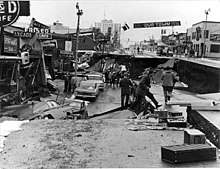Karfreitagsbeben 1964


Das Karfreitagsbeben, auch Großes Alaska-Beben genannt, war das bisher stärkste einzelne Erdbeben in der Geschichte der USA. Nach dem Erdbeben von Valdivia 1960 ist es das Megathrust-Erdbeben mit der zweithöchsten Magnitude seit Beginn der ab etwa 1950 durchgeführten regelmäßigen Aufzeichnung von Erdbeben.
Es ereignete sich am 27. März 1964 um 17:36 Uhr Ortszeit (28. März, 03:36 Uhr UTC) und hatte eine Momenten-Magnitude von 9,2 MW.[1] Das Epizentrum lag im Prinz-William-Sund im südlichen Zentral-Alaska. Die meisten Sachschäden gab es in Anchorage, 120 Kilometer nordwestlich des Epizentrums.
Durch das Beben kamen 125 Menschen ums Leben, fast alle durch Tsunamis, die die Fjorde des Prinz-William-Sund und der Kenai-Halbinsel heimsuchten und eine maximale Höhe von etwa 67 Metern erreichten.[2] Opfer wurden auch aus Kalifornien und Oregon gemeldet.[3] Das Beben dauerte in Anchorage beinahe drei Minuten. Die größten Zerstörungen in der Stadt wurden durch Erdrutsche und massive Landverschiebungen verursacht. Beinahe jedes Haus in der Nähe der Turnagain Heights wurde durch das Beben zerstört.
In dem Roman Der Geruch von Häusern anderer Leute der US-Amerikanerin Bonnie-Sue Hitchcock von 2016 spielt das Beben eine wesentliche Rolle, insofern es für einige der jugendlichen Protagonisten, wegen des Seetods ihres Vaters, eine lebensentscheidende Rolle spielt.
Literatur
- George Plafker: Tectonic Deformation Associated with the 1964 Alaska Earthquake. In: Science. Band 148, Nr. 3678, 1965, S. 1675–1687, JSTOR:1716697.
- George Plafker: Tectonics of the March 27, 1964 Alaska Earthquake (= The Alaska Earthquake, March 27, 1964: Regional Effects. I = Geological Survey Professional Paper. 543-I, ISSN 0096-0446). United States Government Printing Office, Washington DC 1969, (online).
- George Plafker: Alaskan earthquake of 1964 and Chilean earthquake of 1960: Implications for arc tectonics. In: Journal of Geophysical Research. Band 77, Nr. 5, 1972, ISSN 0022-1406, S. 901–925, doi:10.1029/JB077i005p00901.
- National Research Council – Committee on the Alaska Earthquake of the Division of Earth Sciences: The Great Alaska Earthquake of 1964. National Academy of Sciences, Washington DC 1971–1973.
Weblinks
- Marc Pitzke: Das Beben, das Amerika weckte. In: einestages vom 27. März 2014.
- Andrew Alden: 50 Years Ago, Alaskan Earthquake Was Key Event for Earth Science. KQED Science, 27. März 2014.
Einzelnachweise
- ↑ Bericht des U.S. Geological Survey: The Great M9.2 Alaska Earthquake and Tsunami of March 27, 1964. usgs.gov. Abruf am 10. Mai 2020 (englisch)
- ↑ M 9.2 – 1964 Prince William Sound Earthquake, Alaska usgs.gov. Abruf am 10. Mai 2020 (englisch)
- ↑ Tsunami Event: Prince William Sound, AK. Daten zum Tsunami, National Geophysical Data Center, NOAA
Koordinaten: 61° 1′ 12″ N, 147° 39′ 0″ W
Auf dieser Seite verwendete Medien
Collapse of Fourth Avenue near C Street, Anchorage, due to the 1964 Alaska earthquake of March 27, 1964 which caused a landslide.
Autor/Urheber: USGS, Lizenz: CC BY-SA 3.0
"1964 Quake: The Great Alaska Earthquake" is an eleven minute video highlighting the impacts and effects of America's largest recorded earthquake. It is an expanded version of the four minute video "Magnitude 9.2". Both were created as part of USGS activities acknowledging the fifty year anniversary of the quake on March 27, 2014. The video features USGS geologist George Plafker, who, in the 1960's, correctly interpreted the quake as a subduction zone event. This was a great leap forward in resolving key mechanisms of the developing theory of plate tectonics. Landslide impacts and the extreme tsunami threat posed by these quakes are also discussed. Loss of life and destruction from the earthquake and accompanying tsunamis was the impetus for things like the NOAA Tsunami Warning Centers and the USGS Earthquake Hazards Program.


